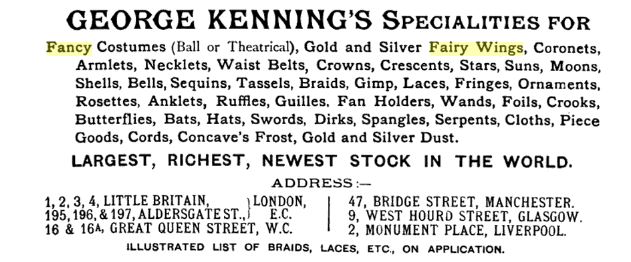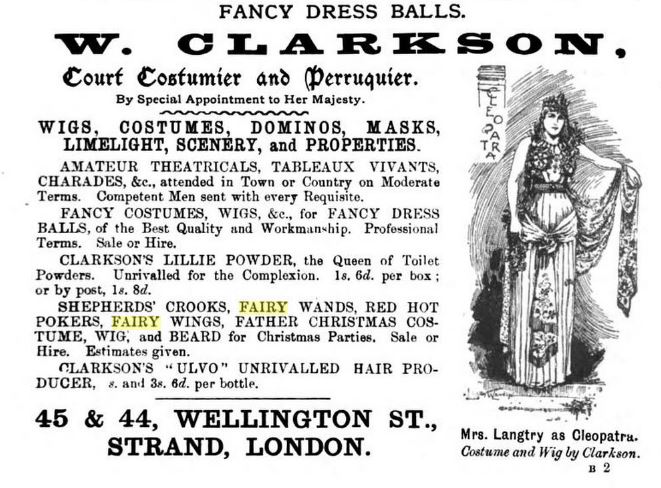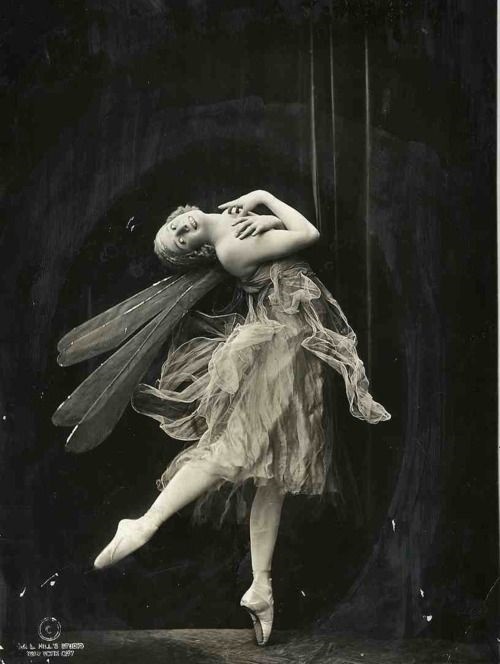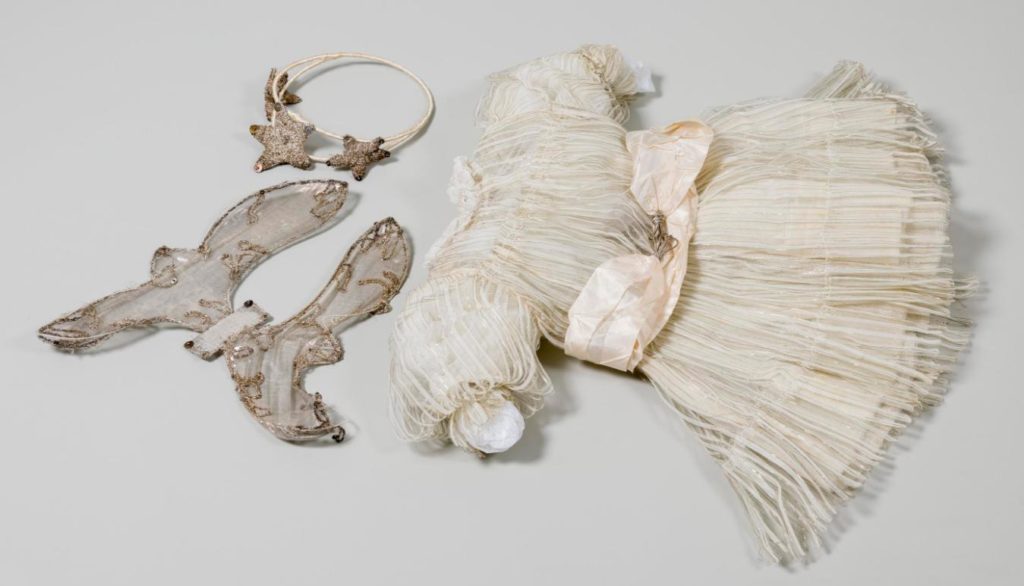Making Fairy Wings December 18, 2016
Author: Beach Combing | in : Modern , trackback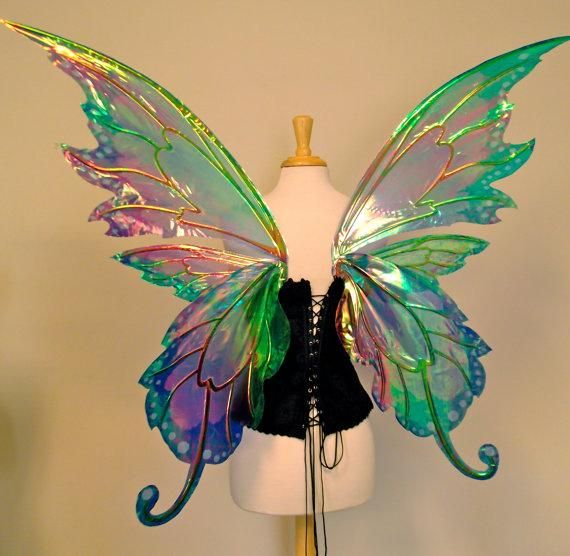
After yesterday’s post on the origin of fairy wings, Beach now asks a parallel question. If from the later 19C children were wearing fairy wings at parties who actually made the damn things. Today there are special firms. What about in 1850 or 1890 or 27 October 1933. Here is a short article from that date from the Leeds Mercury, page six.
I have been to the shop [Viyella in Leeds apparently] where they make fairies’ wings. It is a store famous for many other things, but to me it stands for silver wings, lovely gossamer affairs that the girls stitch while standing at the counter and which go to make real the dreams of countless little girls over the party season. The point is that, when coming away from the back scenes of fairyland, the sight of some bright red woollen gloves was a vigorous reminder that little girls cannot live on tinsel: they must have warm woolly things to fight the coming cold. [Joyce Mather in a column entitled ‘Where Fairies’ Wings are Made’]
Leeds Mercury, 27 Oct 1933
Can anyone predate this and give us an earlier systematic attempt to make fairy wings among artisans? drbeachcombing AT yahoo DOT com We have a homemade recipe picked up from the Girl’s Realm in 1908.
‘Fairies,’ says Mrs Elizabeth Seymour Norton in this month’s Girl’s Realm ‘have wings, and everybody knows that if children wearing wings sit down, the fragile things, that took such hours to make, will be crumpled and torn as if tiresome elves had teased them their way the fairy frolic. It is this point that we remember an illustrated article on stencilling which appeared in the January number of ‘The Girl’s Realm.’ Instead of making wings out of wire, and covering them, cut long, sleevelike draperies, in the shape of butterflies’ wings for instance, and on these stencil the brilliant and beautiful colours., I wonder if the meaning clear to you? Imagine a little girl standing in a dainty muslin gown which hangs in plain, graceful folds. As she remains still it appears as if the sleeves were made very full on the shoulders, there are gleams and touches of colour only, but suddenly she extends her arms, raising them prettily; her fingers help spread out the draperies, and turns and dances gracefully before you. your eyes see a radiant pair of wings unfolded. The shapes and colours the wings of butterflies, moths, birds, bees, dragon-flies, etc., may delight the eyes of an audience by means of stencilling. Elastic will help you cunningly and well, if you use it on the inner side of your drapery. Can you picture the sight? A number of dainty figures steal through the screen of greenery, figures in white, cream, and the varied shades of yellow. Delicately they tip-toe before you. Suddenly, to inspiring music, their arms flash out, and your eyes feast harmonising movement, emphasised by a wealth of colour.’ Belper News (7 Feb 1908), 5
By 1908 there was already a correct way to make fairy wings then. This is a subversive take on the same.
Chris from Haunted Ohio Books, 8 Jan 2017, has been sending some of these fragments of fairy records. I put them here hoping others will fall out. She’s also found battery powered fairy costumes from 1908! Brilliant stuff.
1) “The Pilgrim’s Progress” has been adapted to the London stage, with what “The Times” severely describes as “a rouged and bewigged representation of the Archangel Michael in pink fleshings and pantomime fairy wings.” From a long article called “Religious Plays and Moralities” on the revival of religious drama in England. Press [Canterbury NZ] 21 February 1903: p. 6
2) The Music of this song is published on the last page of the present Number of the Singer’s Journal.
If wishes only would come true,
How happy I should be!
I’ve no wish in balloons to ride,
Nor go beneath the sea,
No doubt, you’ll think it funny, but
Of all unheard of things,
I’d like to be a fairy, with
A pair of paper-wings.
Chorus: I should like to be a fairy.
So graceful, light, and airy;
How nice to be a fairy
With a pair of paper-wings!
If I had fairy-wings, you know,
I’d tease, out of their lives.
Old bachelors and flirting men,
Who won’t make girls theirs wives.
I’d hover round their haunts and show
The joy a wedding brings,
And try to touch their stony hearts
With cupid’s fairy wings.
Chorus.
I’d try to show the wealthy few
The good they might ensure,
With fairy-wings of Golden hue,
Amidst our starving poor;
I’d teach those in sumptuous homes
That poverty oft brings
The poor to lose its honesty,
Thro’ want of golden wings.
Chorus
We’ve all our different fancies, let
Them be whate’er they may;
If we wish to do the heavy, why,
Then for it we must pay.
So when upon the “fly,” my boys,
Your sprees and little flings,
Just bear in mind that bank-notes make
The best of paper-wings.
Chorus.
Henry De Marsan’s New Comic and Sentimental Singer’s Journal, Issues 1-60, 1871, p. 335
3) [describes children putting on “Sleeping Beauty”] Whilst the little actors were thus learning their parts, their kind mothers were preparing suitable raiment-charming court suits for “ lords-inwaiting,” pages, and for the king himself. Fairies’ wings and wands and wreaths were made in this house by the deft fingers of voluntary workers,
and many of them had to be made ; for, although there were only three principal talking fairies, they had various attendants, that being the happiest and, indeed, only practicable method of bringing before the footlights, to delight the eyes of parents and friends, the tiniest and prettiest of our children.
The very youngest fairy was actually only three and a half years old, and a better-behaved, more responsible little being never breathed. The fairies’ wings shone and sparkled with mica dust thickly sprinkled upon wet gummed net stretched on wire frames made in the form of the conventional fairy’s wings, whilst the wands and shoes were covered with silver-foil paper that had been first crushed and crumpled to give it a burnished look; wreaths of stars cut out of cardboard and covered with the silver foil adorned the little ones’ pretty shining heads.
The “bad fairy’s” costume, most especially the sugar-loaf hat, was a great success;
“The Countess of Buchan; or, A Story of What Children Did for Children,” in Aunt Judy’s Annual Volume, Volume 4: 1885 p. 104
4) A couple of fairy wing adverts…
25 Feb 2017, Lisa Lideks supplies this inspired pair of fairy wings. Lisa has no idea but c. 1890? Interesting structure…
31 Mar 2017: Chris from Haunted Ohio Books has come up with this blinder, a well preserved (Edwardian?) fairy wing outfit now in a Welsh museum.

